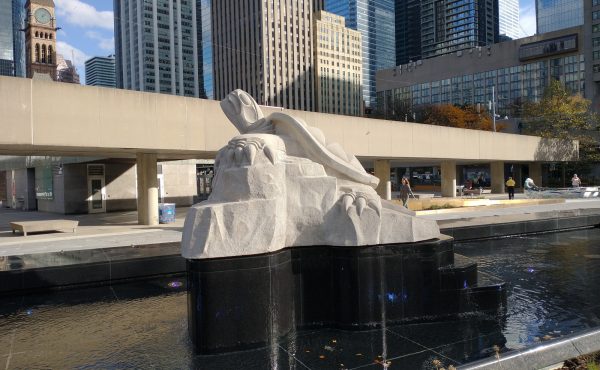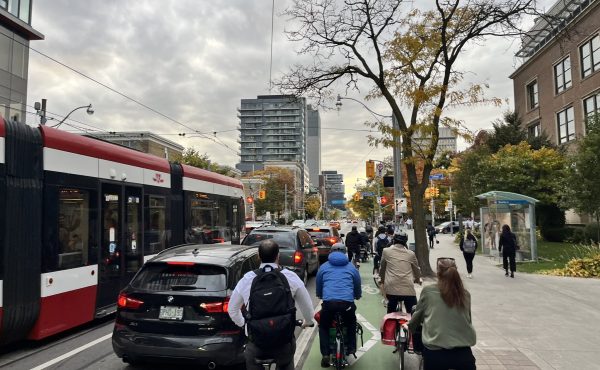
NEW YORK — It definitely takes a person of great fortitude to become a New York City cyclist. A daily trip may involve encounters with wayward taxis, delivery trucks, massive potholes, and police blitzes that questionably target cyclists. That being said, the city has taken notice of the increasingly gridlocked traffic with its obvious environmental effects and has decided to invest in the cycling network. In September 2006, Mayor Bloomberg committed to the construction of 322 kilometers of on street bike lanes, termed Class II, at a cost of $19,000 USD per kilometer which is to be added to the already existing 467 kilometers of Class II lanes.
New York City, including the boroughs, has a total of 790 kilometers of bike lanes and 10,000 kilometers of roads, but according to Chris Gilbride, a Department of Transportation spokesperson, “The bike network is growing by the minute so the number is approximate.†These lanes are divided into three Classes. Class I is a bike lane physically separated from traffic. This represents about 2 kilometers of the network, and can be seen in the new installation on 9th Avenue, which I will describe later on. Class II is a bike lane designated by a solid line running parallel to the curb with an average width of 4-6′ and Class III bike lanes have to share the road with regular vehicular traffic with no differentiation aside from a sign designating it as a bike route.
It appears as though 9th Avenue has becomes New York’s new pedestrian experiment. I’ve documented the continuing development of the city’s first woonerfs in several irregular intersections on this Avenue, and now the city has taken to installing a new type of bike lane. 9th Avenue has the fortune, like most of the north-south avenues, of being quite broad, 4 lanes of driving and 2 lanes of parking. The city has used this girth to its advantage. By pushing the parking out 10′ away from the curb, an ample bike lane is created which is buffered from the fast moving traffic by the parked cars. To further provide safety for the cyclists the parked vehicles are buffered by an 8′ wide strip of asphalt or concrete median so as to prevent opening doors from becoming an issue. Unfortunately the city has decided not to take this opportunity to create a beautiful allee of trees along this 8′ median, instead leaving it as a barren strip of concrete and asphalt. This median could have become a dramatic visual statement in the landscape while providing much needed clean air and shade for both the cyclists and parked cars.
At least for now this is good start and a positive direction for the city’s cyclists. There are plans in the works to construct more Class III bike lanes on some of the broader east west streets in order to connect disparate portions of the network. Due to the lack of sufficiently wide streets only portions of the city will get these segregated lanes. I assume these lanes will act as the bicycle highways while the narrow streets will function as the feeder routs from the inner neighbourhoods. The network is developing rapidly with a strong focus on connectivity and so far the 9th avenue bike lane appears to be working well. Just imagine the day when there are bicycle traffic jams.
– – – – – – – – – – –
Joe Clement, a long-time Spacing magazine contributor, left his hometown of Toronto in August and is now living in New York. He will be our Big Apple correspondent covering public space issues.




18 comments
Copenhagen has signal priority for bikes! Well, it would be Compenhagen or Amsterdam, but recently it seems like Copenhagen is the place. Here’s what we need in this city. Can you imagine one along Bloor?
http://copenhagengirlsonbikes.blogspot.com/2007/11/bike-lane-simplicity.html
The real obstacle to bike lane implementation (as well as streetcar ROWs or sidewalk widening) in Toronto isn’t a lack of initiative but the vise-like grip that merchants have on on-street parking. For some reason, they consider OSP sacred and city hall doesn’t want to step on their toes.
I would like to know exactly what percentage of retail trips to Queen street west or the Annex are done by car. From anecdotal experience, I would be surprised if it was more than 25%.
We wouldn’t even have to remove parking on both sides of the street; one side could be for parking and the other would be wide enough for a 2-lane ‘bike highway’.
Those Class I bike lanes look great!
“I would like to know exactly what percentage of retail trips to Queen street west or the Annex are done by car. From anecdotal experience, I would be surprised if it was more than 25%.” Quite right Leonard, and moreover, aren’t the most desirable retail locations those that are accessable on foot, bike and transit? That describes the Bloor-Annex, Yorkville, Danforth, Beaches, Queen West, and the few other decent strips in this city.
As for your 25% of customers being drivers, just what percentage of those could find a spot on the main street instead of a side-street or parking lot: 10%? 10% of 25% is f-all. Seems to me that we’d more than make up the loss of that 2.5% by more cyclists and pedestrians. Oh yeah, I also have more disposable income, because I don’t own a car.
Then again, we are not a ‘world-class city’. We are a typical middling mid-west city, as shown by the priority to cars.
Good point Leonard.
There doesn’t seem to be a lot of logic and evidence behind the typical merchant opposition to bike lanes. It makes me think that more communication and education with the BIAs might turn present-day battles into future win-win agreements.
For streets to be successful you need a balance of pedestrians, bikes and cars. While the direct links between car drivers and shopping may not be visible, the greater accessibilty options including cars are a reality of North American cities.
As for not being a world class city because we favour the car, London especially and to a lesser degree New York are far more car-centric than Toronto.
That 9th Avenue example looks terrible, I’m all for bike lanes but that takes up way to much space. As for planting that buffer zone with trees, it would be pretty hard, what with the tunnels for servicing and subways happening under many of New Yorks streets.
9th Avenue is not perfect but the concept of a seperate raod for bikes is a good idea. Its like an HOV Bike lane.
When someone says, “I’m all for bike lanes but that takes up way to much space” and “For streets to be successful you need a balance of pedestrians, bikes and cars”, then implies that such ‘balance’ is the status quo “the greater accessibilty options including cars are a reality of North American cities”, I don’t think he’s onside, do you? I also think he has the sort of thinking which created the sprawling and generic city we have.
Oh yeah, how about: “As for not being a world class city because we favour the car, London especially and to a lesser degree New York are far more car-centric than Toronto”?
Has he been to these places?! Has he heard that one of those two cities has a congestion charge?
Hey Aidan
I just moved from New york City where I was living for a year, to London where I have been now living for 4 months, before that I lived in Toronto for 5 years and Vancouver for 3, and biking in all of them.
That 9th Avenue example is the equivalent of the Hurontario of bike lanes, its poor design.
The congestion charge doesn’t mean that London is a bike zone, if anything it means that the government has identified a means of collecting revenue, and to attempt to shift some of the car traffic to public transit or walking/cycling, the bulk of the cars in London and New york come from within the congestion zone or proposed congestion zone in NYC’s case.
Oxford/Theobald’s/Clerkenwell/Old Street one of the major east/west streets running across London has tonnes of buses, cars, bikes and pedestrians zipping both ways in a 50 right of way, about 10-15 feet less than Harbord.
Love your accusational tone, makes for great forum dialogue.
Whatever. No one cares about anyone’s “accusational tone”.
Toronto not only should, but needs to do much more to “shift some of the car traffic to public transit or walking/cycling”, both because there isn’t the room or money to build enough driving and parking space, and because the health of its citizens and civic-culture requires more people out of cars. You have a city where everyone drives, and you have fatter people and more with diabetes, living in a city that is unsafe to walk in anymore.
There is also the crudest money argument. If you want less traffic congestion, build up transit: a transit dollar goes much further by getting people off the road, than a road dollar does before it is quickly congested by another car.
Don’t hold your breath Toronto this city council isn’t very interested in implementing the bike lane structure required.Innstead they throw in lanes on Lansdowne and forget Bloor street.The likes of Joe Pantalone were easy to promise to get elected and now have flip-flopped! And you thought only Liberals break promises….I am still surprised at the amount of taxi expenses by the councillors for short local trips.I guess even they feel the lack of bike lanes push them into vehicles.
When oh when will Joe Pantalone post an explanation here about his stance on this issue???
Please remember this is just a start in New York… many more of these Class I lanes need to be built. I’ve been pushing for them in Milwaukee hopefully all North American cities will make a move to add them.
I like the idea of the protected bike lane, and also on-street parking, although the biggest disadvantage is the massive Right-of-way (ROW) this design solution needs.
We are talking 4 lanes of traffic, 2 lanes of parking, 2 buffer strips and 2 dedicated bike lanes which would add up to approximately 92 feet atleast. This creates a very large crossing for pedestrians. The advantage in keeping the parking closer to the sidewalk is that it allows for intersection bulb-outs that can effective reduce the crosswalk distance by 16 feet.
Trees will help reduce the perception of the huge ROW. Even if thye cannot be planted in the street, you could have smaller street tree varieties that can be grown in 3foot high planter boxes. Correct placement of these can help in making the space between them a good refuge island.
I’m from Copenhagen – and yes we do have bicycle traffic jams 🙂
James is way off base. I lived in London for 4 years and I can tell you it is not a car-centric city. It is definately not bike friendly, but most people get around by foot or transit. Yes it seems like there are lots of cars, but the road network is much smaller. Plenty of people drive into the congestion zone from nearby nieghborhoods, but those are wealthier residents. Whenever colleagues of mine would come into the city for business meetings they would usually park there cars outside the business District (HAmmersmith Tube stop) and use the underground in the central core. Having cars on the road does not make you car-centric. Having to rely on cars for the majority of your trips does. London is like San Francisco (the city not the bay area), cars are for getting out of the city or for getting around on weekends, but most people commute to their 9-5 jobs, and go out for their evening entertainment by transit (or taxis, which are cars but again do not imply car-centricity).
sorry “their” cars not “there” cars.
In a way, going for cycle tracks (class 3) is giving up a main portion of the street to motor vehicles. 2 big disadvantages: left turns by cyclists are harder, intersections harder/less safe.
In Missoula, Montana we are calming all arterials with road diets- all 4-lane roads are being changed to 3-lane roads with wide bike lanes. I think it’s important to fight for livable streets instead of separation (off-road urban trails and neighborhood bike boulevards provide a good separation niche for cycling though).
Yet, in the big cities, perhaps the crazy, fast, distracted car culture dictates that class 3 is the only current, reasonable solution.
-Bob g. Msla Inst. for Sus Trans